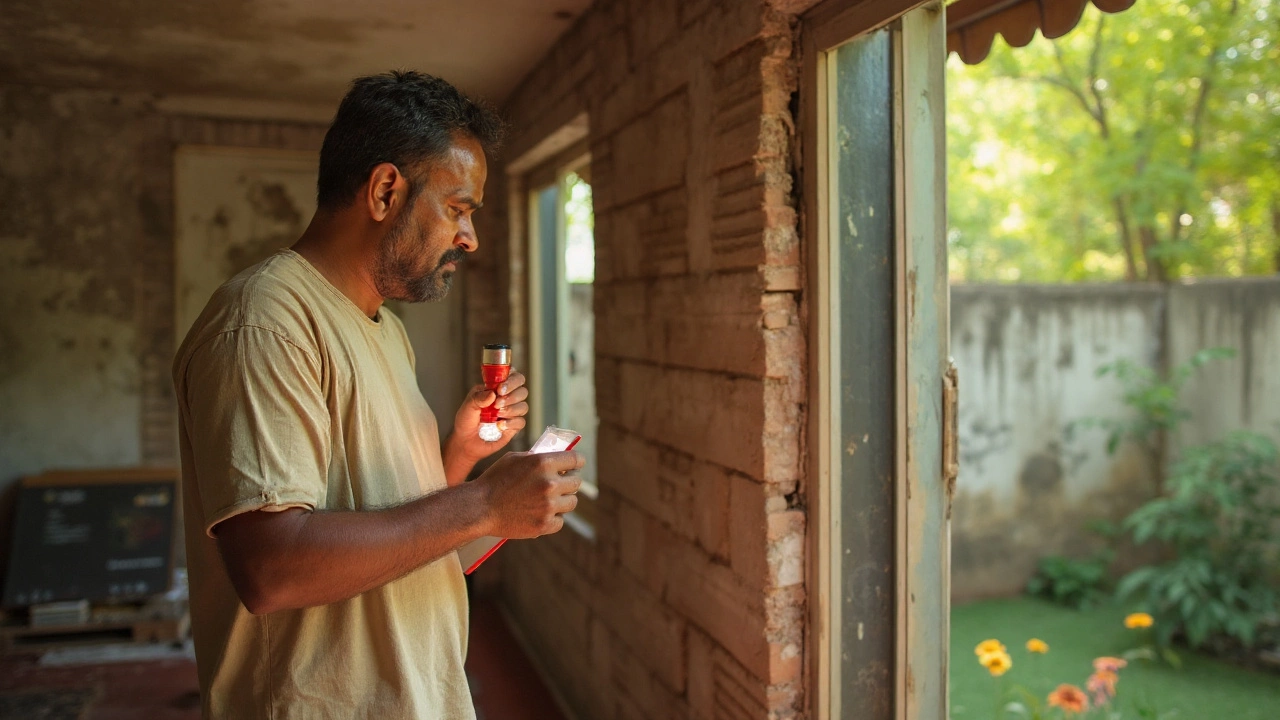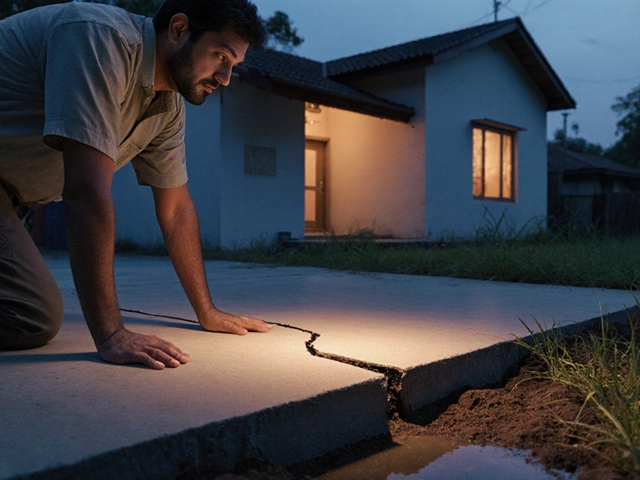One day you step outside and notice a zigzag crack snaking up your basement wall. Or maybe your doors stick, and the floors feel like they belong on a pirate ship in a hurricane. It’s the stuff of homeowner nightmares—and naturally, your first thought is: can I fix the foundation myself? Is it as simple as pouring concrete and slapping on some plaster, or is there a reason folks spend thousands hiring pros?
Understanding Foundation Damage: Not Just a Cosmetic Problem
Most people spot hairline cracks or some basement puddles and shrug them off. Thing is, not all cracks are created equal. Foundations crack for different reasons: soil shifts from heavy rain, trees sucking up moisture, shoddy construction, or houses settling over time. Small cracks under 1/8 inch? Sometimes it’s just the house aging. But when those cracks widen, climb the walls, or come with doors that won't close, you’re looking at a possible structural risk—a real threat to your home’s stability.
According to the American Society of Civil Engineers, about a quarter of U.S. homes will experience some type of structural distress during their lifespan, often related to shifting soil and water issues beneath the home. Most common culprits? Clay-heavy soils that swell and shrink, droughts drying things out, broken pipes, and tree roots getting thirsty. Once the ground moves, the foundation moves right along with it. That’s why it’s not just about looks: foundation problems mess with everything above, from your walls to your roof timbers. A National Association of Realtors survey in 2023 found that fixing foundation problems early can increase your property’s value by 10%, while ignoring them can tank resale prices or even scuttle deals entirely.
The real risk comes when you underestimate what’s happening below ground. Gaps under footings? Sinking concrete slabs? Tilting walls? Those can lead to major repairs costing $10,000 or even $50,000 if left unchecked. So, the real question is whether you can spot harmless flaws from the ones that spell trouble—and when you do, how much you can tackle yourself before needing backup.
What You Can Fix Yourself: Small Repairs for the Confident DIYer
Say you’ve done a little sleuthing and figured out some cracks are small, straight, and not getting bigger. These hairline cracks, especially if they stay dry or aren’t near doors and windows, are fair game for DIY. Filling foundation cracks is basically sealing out water and stopping pests, not rebuilding the basement. Epoxy crack injection kits are sold at hardware stores, costing around $60–$150. Polymer-based fillers also work and don’t need pro-level tools: a chisel, wire brush, and a tube of caulk gets you started.
Got a bit of crumbling mortar between bricks? You can clear out loose chunks, mix new mortar, and pack it in. Keep in mind that preparation is half the battle. Clean out dust and debris, dry out the area, and choose the right filler for the job. Here’s the honest bit—DIY repairs are band-aids. They stop moisture, look neater, and hold for a while, but don’t cure movement or major settling. Ugly cracks in a garage floor are another place to try your hand. Cleaning out the crack, filling it with self-leveling compound, and smoothing it over beats leaving it wide open for water or ants.
Besides sealing up cracks, you might try some basic water management. Gutters dumping water by the foundation? Grab some extenders. Grade soil away from the house to keep water from seeping in. These jobs can make a surprising difference: one 2022 study out of Texas A&M University showed that 44% of foundation issues tracked back to poor site drainage. Fixing gutters is dirty work, but way cheaper than hoisting up your house on steel piers.
So, for confident DIYers with the right mindset and safety gear: you can fix cosmetic cracks under 1/8 inch, patch mortar, seal up leaks, and steer rainwater away from your home. Any project bigger or deeper than that? That’s where you need to stop and assess the risk.

DIY Foundation Repair: Where It Gets Risky and When to Call in the Pros
Rolling up your sleeves and grabbing a trowel feels good—right up until the job gets dangerous. Here’s the hard truth: actual structural repairs, like fixing bowed walls, sinking footings, or foundations shifting inches out of level, are not DIY territory. Moving heavy concrete, driving steel piers, or hauling beams takes special know-how and equipment, not to mention permits and insurance.
The National Association of Home Builders reports that shoddy DIY structural repairs often make things worse. Lifting a slab too fast can cause pipes to snap. Adding supports in the wrong spot may push pressure elsewhere, cracking bricks or skewing doors across the house. And if you use the wrong materials—like low-strength concrete or the wrong mix for your climate—those fixes might last just a season.
DIY foundation lifts, using floor jacks and wood posts, are found all over YouTube, but rarely end well. Jacks slip, posts rot, and the problem creeps back. Most insurance companies refuse to cover damage from unauthorized repairs, and some mortgage lenders demand reports from licensed contractors. There are cases of homeowners attempting to underpin their houses with homemade concrete piers, only to wind up with collapsed crawlspaces or new cracks all over.
Want hard numbers? The Foundation Repair Association did a 2024 survey showing that professional repairs, though costly, have a 92% long-term success rate, compared to about 30% among DIY jobs. You’re also legally required to get permits in most cities for structural repairs; skip them, and you could face court orders to tear out all your hard work. For cracks bigger than 1/4 inch, walls bulging inward, or floors settling more than an inch, time to hit the pause button and get expert advice. Qualified pros use laser levels, ground-penetrating radar, and engineering reports—stuff you can’t buy at the home store.
Know the Process: What Happens When You Hire a Foundation Repair Professional
If your problem outgrows a caulking gun, calling in a foundation repair company isn’t just about fixing the issue—it’s understanding what’s going on underneath. Reputable contractors do more than slap on patches. They check the grade of the land, take moisture readings, look for evidence of previous repairs, and sometimes even work with geotechnical engineers.
Here’s what you can expect when the pros take over:
- Inspection and Assessment: First, your contractor will inspect visible cracks, measure differences in floor height (usually with digital levels), dig test holes, and maybe even bring in soil specialists. They look for telltale signs—like stair-step cracks, bowing walls, or gaps outside where the soil sinks next to the foundation.
- Engineering Solutions: Depending on the cause—expanding clay, erosion, poor drainage—the fix varies. They might suggest piers driven deep below the shifting soils, mudjacking (injecting grout under sunken slabs), wall anchors, or even foundation wall rebuilding if things go haywire.
- Permits & Documentation: Pros obtain permits, handle city inspections, and document everything for future buyers and insurance claims. Skipping these steps might haunt you during future sales or refinancing.
- Work Timeline: Small jobs take two or three days. Large jobs, where the foundation needs underpinning or the house gets jacked up, might last one to three weeks. Most companies guarantee their repairs for at least 10-25 years (or for the life of the house) because they know how wild soil can get over time.
To give you an idea of how repairs break down, check out this simple table:
| Repair Type | DIY Possible? | Average Cost | Description |
|---|---|---|---|
| Small Crack Filling | Yes | $50–$200 | Sealing minor, non-structural cracks |
| Bowing Wall Repair | No | $4,000–$12,000 | Wall anchors, steel braces, or carbon fiber straps |
| Underpinning | No | $10,000–$50,000 | Piers or pilings supporting the home from beneath |
| Drainage Correction | Sometimes | $500–$4,000 | Gutter, grading, and landscape changes |
| Slabjacking / Mudjacking | No | $2,000–$6,000 | Injecting grout to lift slabs |
Even if you bring in a pro, many repairs involve digging up flower beds, busting up patios, and heavy work that isn’t a weekend project. The upside is, unlike a poorly patched DIY job, solid repairs give you peace of mind and a shot at a solid resale value.
So, can you *repair foundation* yourself? Sure, if you’re sealing tiny cracks, tweaking gutter slopes, or patching minor leaks. When it comes to anything bigger—if the house moves, walls bow, or cracks keep spreading—call in the folks with the trucks, jacks, and know-how. You’ll thank yourself when the doors open without a fight, and that crack stays a memory, not a disaster.






